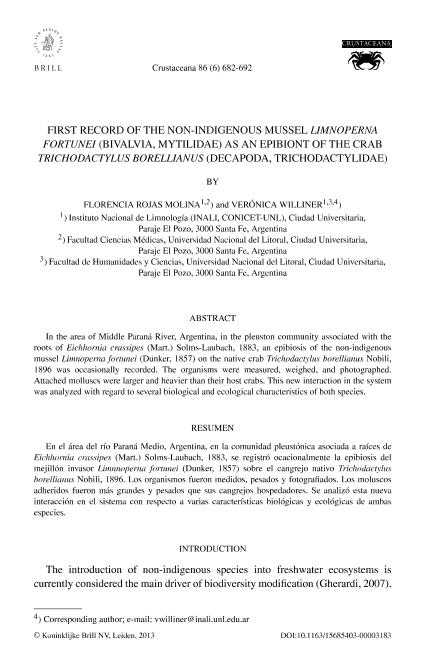Artículo
In the area of Middle Paraná River, Argentina, in the pleuston community associated with the roots of Eichhornia crassipes (Mart.) Solms-Laubach, 1883, an epibiosis of the non-indigenous mussel Limnoperna fortunei (Dunker, 1857) on the native crab Trichodactylus borellianus Nobili, 1896 was occasionally recorded. The organisms were measured, weighed, and photographed. Attached molluscs were larger and heavier than their host crabs. This new interaction in the system was analyzed with regard to several biological and ecological characteristics of both species. En el área del río Paraná Medio, Argentina, en la comunidad pleustónica asociada a raíces de Eichhornia crassipes (Mart.) Solms-Laubach, 1883, se registró ocacionalmente la epibiosis del mejillón invasor Limnnoperna fortunei (Dunker, 1857) sobre el cangrejo nativo Trichodactylus borellianus Nobili, 1896. Los organismos fueron medidos, pesados y fotografiados. Los moluscos adheridos fueron más grandes y pesados que sus cangrejos hospedadores. Se analizó esta nueva interacción en el sistema con respecto a varias características biológicas y ecológicas de ambas especies.
First record of the non-indigenous mussel Limnoperna fortunei (Bivalvia, Mytilidae) as an epibiont of the crab Trichodactylus borellianus (Decapoda, Trichodactylidae)
Fecha de publicación:
03/2013
Editorial:
Brill Academic Publishers
Revista:
Crustaceana
ISSN:
0011-216X
e-ISSN:
1568-5403
Idioma:
Inglés
Tipo de recurso:
Artículo publicado
Clasificación temática:
Resumen
Palabras clave:
Epibiont
,
Host
,
Biological Invasions
,
Golden Mussel
,
Eichhornia
Archivos asociados
Licencia
Identificadores
Colecciones
Articulos(INALI)
Articulos de INST.NAC.DE LIMNOLOGIA (I)
Articulos de INST.NAC.DE LIMNOLOGIA (I)
Citación
Rojas Molina, Florencia Mercedes; Williner, Verónica; First record of the non-indigenous mussel Limnoperna fortunei (Bivalvia, Mytilidae) as an epibiont of the crab Trichodactylus borellianus (Decapoda, Trichodactylidae); Brill Academic Publishers; Crustaceana; 86; 6; 3-2013; 682-692
Compartir
Altmétricas




